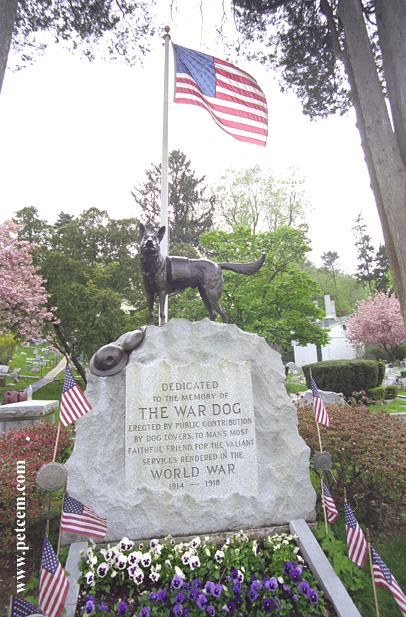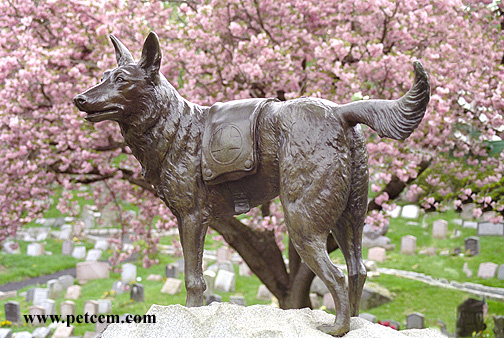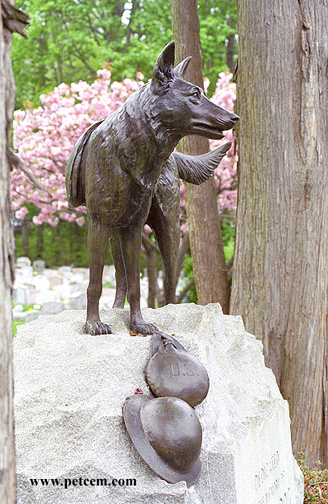HartsdaleLocation: New York
Sculptor: Unknown Dedicated: 10/01/1923
War Dog Memorial
Hartsdale Pet Cemetery
Hartsdale, New York
The War Dog Memorial in Hartsdale Pet Cemetery is first publicly-funded tribute to the dogs of modern combat in America. A ten-ton, six-foot rounded block of Rock of Ages Barre granite with “shell-rock-pitching” treatment to suggest a scarred battlefield hillock is the base for an alertly-posed life size cast bronze male German shepherd wearing a World War I Red Cross blanket. At the dog’s feet is a soldier’s canteen and dented U.S. Infantry helmet of the same medium. Its design, assembly and installation was overseen by Caterson Monumental Works of the Bronx, and according to one newspaper article from 1922, a “well known sculptor” was commissioned to create the dog, although at present his or her identity remains a mystery. America would not join the “war to end all wars” until the last year of conflict in 1918, but already the public knew of the Red Cross Mercy Dogs who assisted critically-wounded soldiers lost in the cratered landscape of the “no man’s land” battlefield. Loosely referred to as “war dogs,” these predecessors to today’s search-and-rescue canines was the brainchild of the British trainer Colonel Edwin Hautenville Richard, who foresaw the need for dogs well before the war started. He pointed to the tremendous casualties of other conflicts, saying it was “certain that with the aid of trained dogs a very large number of the missing could have been located.” It is not surprising, therefore, that the idea of a tribute to the dogs of war was embraced with enthusiasm when it was proposed in the Cemetery’s annual letter to the plot-holders in 1919. “A movement has been started to erect a monument to the dogs of war,” announced the New York Times in the same year. “Unsolicited subscriptions amounting to $450 have been received by the head of the cemetery, and [this already has been increased] to $1000 through the efforts of those interested in the project.” With contributions pouring in (even school children gave their pennies), an ad-hoc committee of unknown individuals assumed responsibility for continuing fundraising efforts. Robert Caterson, the acclaimed designer of cemetery monuments and public works such as Grand Central Terminal, was tapped to oversee the project through to completion. With the help of designer Walter Buttendorf, a concept sketch for the memorial was approved at a final estimated cost of $2,500. Its unveiling in the fall of 1923 was “an international event,” attended by “men and women of all ranks, [who are] anxious to testify that these mute heroes are not forgotten.” In the decades to follow, the Memorial would be ceremonially rededicated to the dogs of all wars, and ultimately to all animals who have given their lives in the wartime service of mankind. Robby the explosives detection dog, who was the inspiration for the War Dog Retirement Act (H.R. 5314), is buried at the foot of the memorial, and there are cenotaphs honoring the search and rescue K9s from the Oklahoma City bombing and 9/11. An annual war dog memorial service is held each year to coincide with National Pet Memorial Day in June, which culminates with the laying of a wreath at the foot of the memorial.
Special Thanks goes to Mary Thurston for updating this information and photos 08/11/2012. |
















